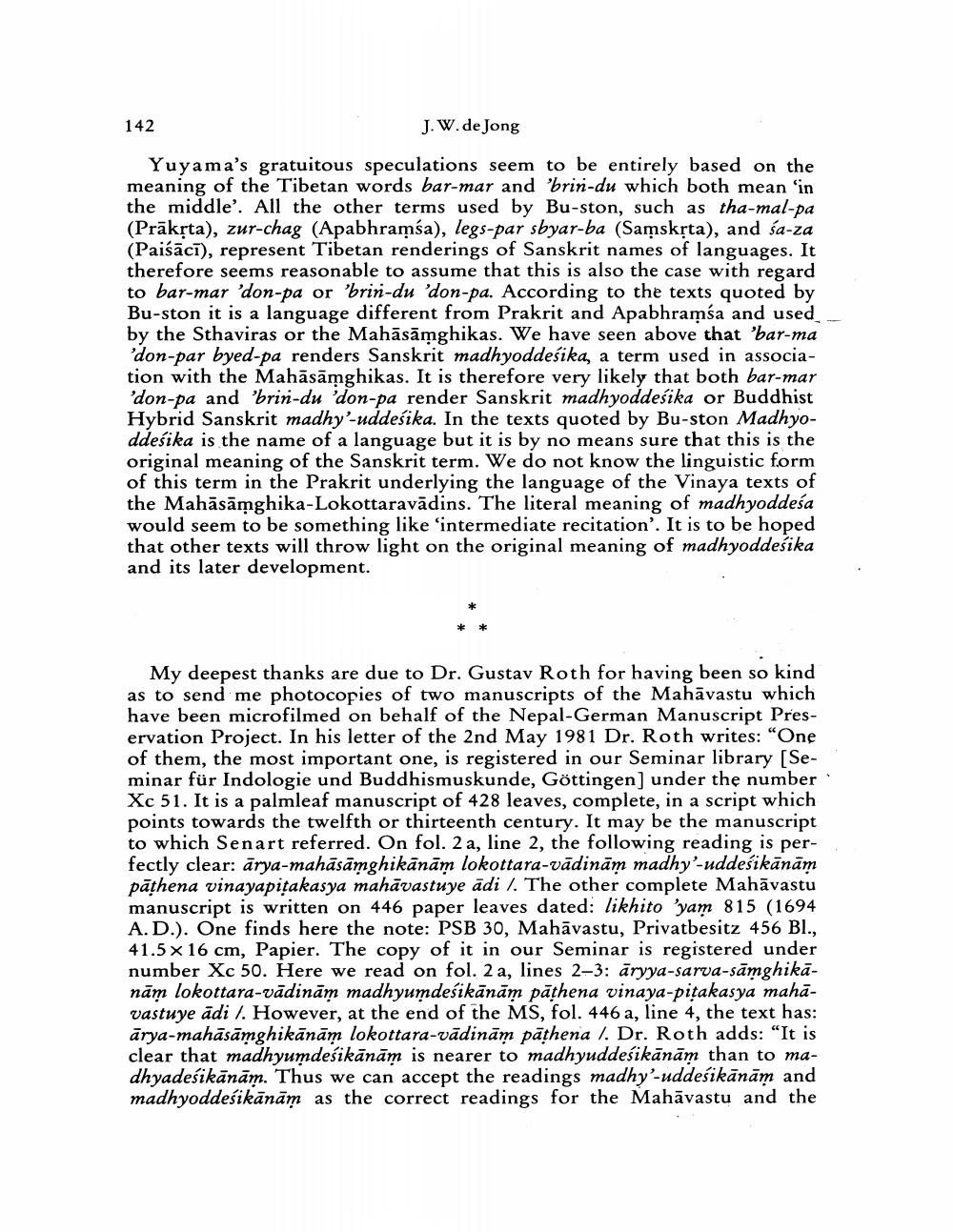Book Title: Madhyadesika Madhyoddesika And Madhyuddesika Author(s): J W De Jong Publisher: J W De Jong View full book textPage 5
________________ J. W. de Jong Yuyama's gratuitous speculations seem to be entirely based on the meaning of the Tibetan words bar-mar and 'brin-du which both mean 'in the middle'. All the other terms used by Bu-ston, such as tha-mal-pa (Prākṛta), zur-chag (Apabhramśa), legs-par sbyar-ba (Samskṛta), and sa-za (Paiśācī), represent Tibetan renderings of Sanskrit names of languages. It therefore seems reasonable to assume that this is also the case with regard to bar-mar 'don-pa or 'brin-du 'don-pa. According to the texts quoted by Bu-ston it is a language different from Prakrit and Apabhramsa and used by the Sthaviras or the Mahāsāmghikas. We have seen above that 'bar-ma 'don-par byed-pa renders Sanskrit madhyoddeśika, a term used in association with the Mahāsāmghikas. It is therefore very likely that both bar-mar 'don-pa and 'brin-du 'don-pa render Sanskrit madhyoddeśika or Buddhist Hybrid Sanskrit madhy'-uddesika. In the texts quoted by Bu-ston Madhyoddesika is the name of a language but it is by no means sure that this is the original meaning of the Sanskrit term. We do not know the linguistic form of this term in the Prakrit underlying the language of the Vinaya texts of the Mahāsāmghika-Lokottaravādins. The literal meaning of madhyoddeśa would seem to be something like 'intermediate recitation'. It is to be hoped that other texts will throw light on the original meaning of madhyoddeśika and its later development. 142 * My deepest thanks are due to Dr. Gustav Roth for having been so kind as to send me photocopies of two manuscripts of the Mahāvastu which have been microfilmed on behalf of the Nepal-German Manuscript Preservation Project. In his letter of the 2nd May 1981 Dr. Roth writes: "One of them, the most important one, is registered in our Seminar library [Seminar für Indologie und Buddhismuskunde, Göttingen] under the number Xc 51. It is a palmleaf manuscript of 428 leaves, complete, in a script which points towards the twelfth or thirteenth century. It may be the manuscript to which Senart referred. On fol. 2 a, line 2, the following reading is perfectly clear: arya-mahäsämghikānām lokottara-vādinām madhy'-uddesikänäm pathena vinayapitakasya mahāvastuye ädi /. The other complete Mahāvastu manuscript is written on 446 paper leaves dated: likhito 'yam 815 (1694) A.D.). One finds here the note: PSB 30, Mahävastu, Privatbesitz 456 Bl., 41.5 x 16 cm, Papier. The copy of it in our Seminar is registered under number Xc 50. Here we read on fol. 2 a, lines 2-3: äryya-sarva-sämghikanām lokottara-vādinām madhyumdeśikānām pāṭhena vinaya-piṭakasya mahāvastuye adi /. However, at the end of the MS, fol. 446 a, line 4, the text has: arya-mahäsämghikänäm lokottara-vādinām pāṭhena /. Dr. Roth adds: "It is clear that madhyumdesikänäm is nearer to madhyuddesikānām than to madhyadesikanām. Thus we can accept the readings madhy'-uddeśikānām and madhyoddelikānam as the correct readings for the Mahāvastu and thePage Navigation
1 ... 3 4 5 6
